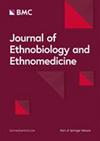民族微生物学的曙光:人类与微生物互动的跨学科研究领域
IF 3.7
2区 医学
Q1 BIODIVERSITY CONSERVATION
引用次数: 0
摘要
民族生物学家通常分析与植物、动物、真菌和生态系统有关的当地知识体系。然而,微生物(细菌、酵母菌、霉菌、病毒和其他生物)在与人类的互动中往往被认为是隐形的,因此常常被忽视。微生物是地球上最早的生命形式,人类与它们的互动贯穿整个历史。随着时间的推移,人类通过嗅觉、味觉和质感等属性积累了关于微生物的生态知识,这些知识指导着对微生物进化环境的管理。这些人类与微生物之间的互动实际上是生物文化多样性的表现形式。因此,我们认为人种微生物学是人种生物学中一个独特的跨学科领域,它研究围绕人与微生物相互作用的管理实践和知识,以及这种方法所能提供的理论贡献。我们查阅了探讨人类与微生物关系的科学期刊、书籍和章节。我们使用与人种微生物学和人种酶学相关的关键词搜索了科学网、Scopus、谷歌学术等数据库和特定期刊网站。为了对涉及人类与微生物之间刻意互动的活动进行分类,我们研究了发酵、腌制、食品保存、青贮、鞣制、烘干、腌制、熏制、传统医药、民间医药、农业实践、堆肥和其他相关实践等主题。我们的研究通过对人类与微生物相互作用的实践和理论见解,特别是对健康、土壤和食物系统的影响,为民族微生物学开创了重要先河。我们还发现,这些互动有助于生物多样性保护和共同进化过程。这一新兴的跨学科领域对食物生态学、公共卫生以及隐蔽微生物景观和群落的生物文化保护具有重要意义。探索微生物群落与人类之间相互交织的关系对社会生态学的影响至关重要。同样重要的是,促进保护和恢复这一巨大的生物文化多样性,以及以当地生态知识为基础的可持续管理实践。随着人种微生物学从描述性方法发展到更具理论性和综合性的生物学方法,认识到人种微生物学的曙光至关重要。我们强调传统社区在保护粮食、农业和健康系统方面发挥的关键作用。这一新兴领域突出表明,民族生物学科学的未来将不再关注单个生物或文化,而是关注微生物与人类之间的共生关系,这种共生关系塑造了无形但往往复杂的生物文化景观。本文章由计算机程序翻译,如有差异,请以英文原文为准。
The dawn of ethnomicrobiology: an interdisciplinary research field on interactions between humans and microorganisms
Ethnobiologists commonly analyze local knowledge systems related to plants, animals, fungi, and ecosystems. However, microbes (bacteria, yeasts, molds, viruses, and other organisms), often considered invisible in their interactions with humans, are often neglected. Microorganisms were the earliest life forms on Earth, and humans have interacted with them throughout history. Over time, humans have accumulated ecological knowledge about microbes through attributes such as smell, taste, and texture that guide the management of contexts in which microorganisms evolve. These human-microbe interactions are, in fact, expressions of biocultural diversity. Thus, we propose that ethnomicrobiology is a distinct interdisciplinary field within ethnobiology that examines the management practices and knowledge surrounding human-microbe interactions, along with the theoretical contributions that such an approach can offer. We reviewed scientific journals, books, and chapters exploring human-microbe relationships. Our search included databases such as Web of Science, Scopus, Google Scholar, and specific journal websites, using keywords related to ethnomicrobiology and ethnozymology. To categorize activities involving deliberate human-microbial interactions, we examined topics such as fermentation, pickling, food preservation, silaging, tanning, drying, salting, smoking, traditional medicine, folk medicine, agricultural practices, composting, and other related practices. Our research identified important precedents for ethnomicrobiology through practical and theoretical insights into human-microbe interactions, particularly in their impact on health, soil, and food systems. We also found that these interactions contribute to biodiversity conservation and co-evolutionary processes. This emerging interdisciplinary field has implications for food ecology, public health, and the biocultural conservation of hidden microbial landscapes and communities. It is essential to explore the socioecological implications of the interwoven relationships between microbial communities and humans. Equally important is the promotion of the conservation and recovery of this vast biocultural diversity, along with sustainable management practices informed by local ecological knowledge. Recognizing the dawn of ethnomicrobiology is essential as the field evolves from a descriptive to a more theoretical and integrative biological approach. We emphasize the critical role that traditional communities have played in conserving food, agriculture, and health systems. This emerging field highlights that the future of ethnobiological sciences will focus not on individual organisms or cultures, but on the symbiosis between microorganisms and humans that has shaped invisible but often complex biocultural landscapes.
求助全文
通过发布文献求助,成功后即可免费获取论文全文。
去求助
来源期刊

Journal of Ethnobiology and Ethnomedicine
PHARMACOLOGY & PHARMACY-
CiteScore
7.30
自引率
16.70%
发文量
66
审稿时长
>12 weeks
期刊介绍:
Journal of Ethnobiology and Ethnomedicine publishes original research focusing on cultural perceptions of nature and of human and animal health. Journal of Ethnobiology and Ethnomedicine invites research articles, reviews and commentaries concerning the investigations of the inextricable links between human societies and nature, food, and health. Specifically, the journal covers the following topics: ethnobotany, ethnomycology, ethnozoology, ethnoecology (including ethnopedology), ethnogastronomy, ethnomedicine, ethnoveterinary, as well as all related areas in environmental, nutritional, and medical anthropology.
Research focusing on the implications that the inclusion of humanistic, cultural, and social dimensions have in understanding the biological word is also welcome, as well as its potential projections in public health-centred, nutritional, and environmental policies.
 求助内容:
求助内容: 应助结果提醒方式:
应助结果提醒方式:


